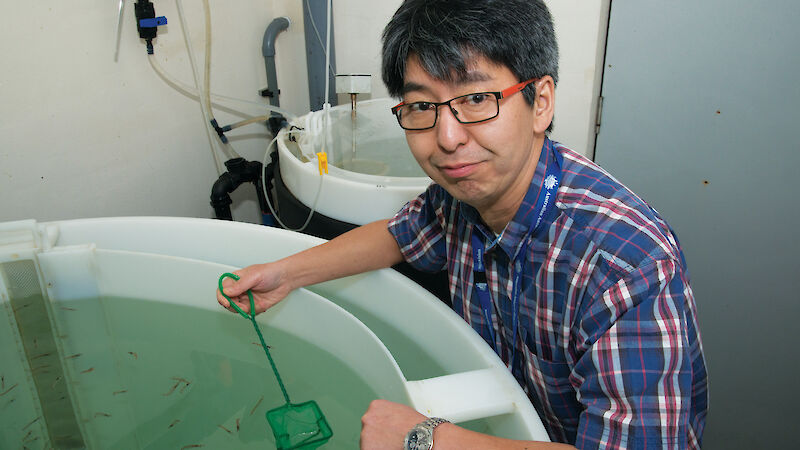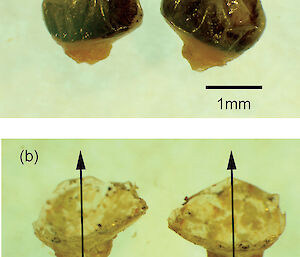Scientists are testing a visionary approach to ageing Antarctic krill — counting annual layers in their eyestalks.
Australian Antarctic Division krill researcher, Dr So Kawaguchi, and his colleagues, Dr Christian Reiss (lead investigator) from the US National Marine Fisheries Service and Dr Raouf Kilada from the University of New Brunswick (St John), Canada, have joined forces to investigate using eyestalks to age Antarctic krill, based on a technique developed by Dr Kilada in 2012 in lobsters, crabs and shrimp.
‘The Australian Antarctic Division’s role in this collaboration will be to provide krill of a known age, grown in our research aquarium in Kingston, to validate this method in the much smaller and more fragile Antarctic krill,’ Dr Kawaguchi said.
The collaborators were recently awarded a $48 200 research grant from the Antarctic Wildlife Research Fund to conduct the work.
‘If the technique works as well for krill as it does for larger crustaceans, we’ll be able to develop more accurate age-based growth models to improve krill fishery management,’ Dr Kawaguchi said.
‘We’ll also be able to compare krill growth in different parts of Antarctica and we’ll have an age-structure baseline against which future changes in krill populations can be observed.’
Unlike many fish and invertebrates that record their age in growth rings deposited in structures such as ear bones, scales and shells, krill do not have any such hard parts that are preserved when they moult. Krill also shrink if food is limited, unlike other crustaceans, so using body length as a proxy for age doesn’t work.
While indirect ageing techniques have been developed, including eyeball size or the accumulation of natural fluorescent pigments in nerve tissue, these are affected by seasonal and environmental conditions, such as food availability and temperature. This complicates comparisons of krill age across areas with different environmental conditions.
‘Our inability to directly age krill limits our understanding of krill ecology, because we cannot compare size at age among areas of the Antarctic with different environmental conditions, or krill growth and recruitment over time,’ Dr Kawaguchi said.
‘It also limits our understanding of the variability in krill population structure — including growth, recruitment and size at age — at local, regional and circum-Antarctic scales.’
In 2012 Dr Kilada found that annual growth bands are formed in the eyestalk of larger crustaceans, which can be counted under a light microscope. The collaborative research team now aim to determine the efficacy of the technique in aquarium-raised krill of known age, as well as wild krill collected during recent and future Antarctic voyages.
The team will also examine krill samples preserved in formalin during research cruises of the US Antarctic Marine Living Resources Program, conducted between 1991 and 2015.
‘If this technique works on formalin-preserved samples it would open up the possibility of making direct comparisons of the size at age of krill in different areas and in different time periods,’ Dr Kawaguchi said.
‘This could include comparing historical growth during Douglas Mawson’s Discovery expeditions in the early 1930s with contemporary samples, or comparing Weddell Sea with Antarctic Peninsula samples.
‘From this we could determine if there’s been any change in the age or the size at age structure of populations and what might have caused that change.’
The research team will provide the results and techniques to members of the Commission for the Conservation of Antarctic Marine Living Resources, to enable the age-based assessments needed for fishery management.
Wendy Pyper
Australian Antarctic Division


